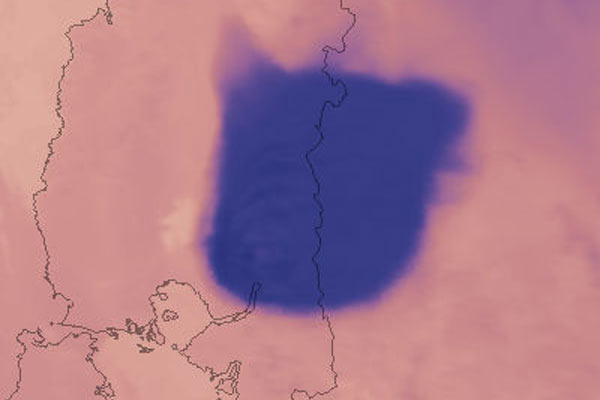Images
April 29, 2015 - Plume from Calbuco volcano, Chile
Tweet
On April 22, 2015, Calbuco volcano in southern Chile began erupting for the first time since 1972. An ash cloud rose at least 15 kilometers (50,000 feet) above the volcano, menacing the nearby communities of Puerto Montt (Chile) and San Carlos de Bariloche (Argentina). The eruption led the Chilean Emergency Management Agency and the Chilean Geology and Mining Service (SERNAGEOMIN) to order evacuations within a 20-kilometer (12 mile) radius around the volcano. About 1,500 to 2,000 people were evacuated; no casualties have been reported so far.
The volcanic mountain was quiet until tremors began late in the afternoon on April 22. An explosive pyroclastic eruption started at 6:04 p.m. local time (2104 Universal Time) and vigorously spewed ash and pumice for at least 90 minutes. Lava flows were observed from the main vent. A second high-energy pulse of ash occurred around 1 a.m. on April 23, according to SERNAGEOMIN.
At 6:35 UTC on April 23 (3:35 a.m. local time) the Aqua satellite flew over the erupting volcano, allowing the thermal bands on the Moderate Resolution Imaging Spectroradiometer (MODIS) on board to capture the heat signature of the eruption. The heat rising from Calbuco appears purple while the surrounding land appears a dull pink. The ocean waters tend to be cooler, and thus whiter in color, than land. The erupting caldera sits roughly in the center of the purple circle, which stretches across both Chile (west) and Argentina (east).
Image Facts
Satellite:
Aqua
Date Acquired: 4/23/2015
Resolutions:
500m ( B), 250m ( B)
Bands Used: Thermal
Image Credit:
Jeff Schmaltz, MODIS Land Rapid Response Team, NASA GSFC
Tweet
On April 22, 2015, Calbuco volcano in southern Chile began erupting for the first time since 1972. An ash cloud rose at least 15 kilometers (50,000 feet) above the volcano, menacing the nearby communities of Puerto Montt (Chile) and San Carlos de Bariloche (Argentina). The eruption led the Chilean Emergency Management Agency and the Chilean Geology and Mining Service (SERNAGEOMIN) to order evacuations within a 20-kilometer (12 mile) radius around the volcano. About 1,500 to 2,000 people were evacuated; no casualties have been reported so far.
The volcanic mountain was quiet until tremors began late in the afternoon on April 22. An explosive pyroclastic eruption started at 6:04 p.m. local time (2104 Universal Time) and vigorously spewed ash and pumice for at least 90 minutes. Lava flows were observed from the main vent. A second high-energy pulse of ash occurred around 1 a.m. on April 23, according to SERNAGEOMIN.
At 6:35 UTC on April 23 (3:35 a.m. local time) the Aqua satellite flew over the erupting volcano, allowing the thermal bands on the Moderate Resolution Imaging Spectroradiometer (MODIS) on board to capture the heat signature of the eruption. The heat rising from Calbuco appears purple while the surrounding land appears a dull pink. The ocean waters tend to be cooler, and thus whiter in color, than land. The erupting caldera sits roughly in the center of the purple circle, which stretches across both Chile (west) and Argentina (east).
Image Facts
Satellite:
Aqua
Date Acquired: 4/23/2015
Resolutions:
500m ( B), 250m ( B)
Bands Used: Thermal
Image Credit:
Jeff Schmaltz, MODIS Land Rapid Response Team, NASA GSFC




